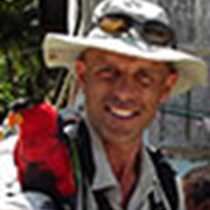Krossfjord, Spitsbergen
It is easy to imagine the Arctic as a cold and barren place. But on the west coast of Spitsbergen the last vestiges of the relatively warm waters of the Gulf Stream exert an influence. Find a south-facing slope on this warmer west coast and the result is the most favourable climate in Svalbard. Place a seabird cliff at the top of this slope, and the combination of climate with the rain of nutrient rich guano produce an area of tundra rich in plant life.
This morning we went ashore at just such a location. At the Hanging Garden of Krossfjord a seabird colony occupies the cliffs high above a raised beach. The steady fall of fertiliser from above produces an unexpectedly green landscape punctuated with bright bursts of campion and saxifrage. This plant growth in turn attracts grazers such as pink-footed geese and reindeer. While the seabird cliffs of Cape Fanshawe support many more seabirds, the majority of their guano falls into the ocean to fertilise marine life that would be unseen by us were it not for Dennis and the Remote Operated Vehicle (ROV).
In Krossfjord we glimpse on land some of the richness of life in the Arctic. But what is the true source of these riches? The land itself would offer little without the guano of seabirds; the seabirds would not be here if it were not for the productive feeding grounds of the Barents Sea. And this afternoon we had the grandest demonstration of the wealth of marine life. As we steamed south off the west coast in perfect, calm, conditions a distant whale blow was sighted. A closer approach revealed a blue whale, the largest species of animal, ever. That such a leviathan would choose these waters in which to feed reinforces what we have already seen in the clouds of seabirds and resultant verdant slopes around their colonies. Making a living in the Arctic may not be easy, but if you know where to look, there are riches here.
It is easy to imagine the Arctic as a cold and barren place. But on the west coast of Spitsbergen the last vestiges of the relatively warm waters of the Gulf Stream exert an influence. Find a south-facing slope on this warmer west coast and the result is the most favourable climate in Svalbard. Place a seabird cliff at the top of this slope, and the combination of climate with the rain of nutrient rich guano produce an area of tundra rich in plant life.
This morning we went ashore at just such a location. At the Hanging Garden of Krossfjord a seabird colony occupies the cliffs high above a raised beach. The steady fall of fertiliser from above produces an unexpectedly green landscape punctuated with bright bursts of campion and saxifrage. This plant growth in turn attracts grazers such as pink-footed geese and reindeer. While the seabird cliffs of Cape Fanshawe support many more seabirds, the majority of their guano falls into the ocean to fertilise marine life that would be unseen by us were it not for Dennis and the Remote Operated Vehicle (ROV).
In Krossfjord we glimpse on land some of the richness of life in the Arctic. But what is the true source of these riches? The land itself would offer little without the guano of seabirds; the seabirds would not be here if it were not for the productive feeding grounds of the Barents Sea. And this afternoon we had the grandest demonstration of the wealth of marine life. As we steamed south off the west coast in perfect, calm, conditions a distant whale blow was sighted. A closer approach revealed a blue whale, the largest species of animal, ever. That such a leviathan would choose these waters in which to feed reinforces what we have already seen in the clouds of seabirds and resultant verdant slopes around their colonies. Making a living in the Arctic may not be easy, but if you know where to look, there are riches here.



